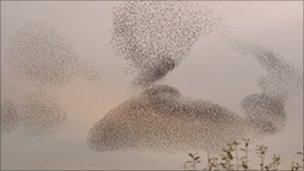Experts urge reporting of starling 'cloud' sightings
- Published

Early evening, just before dusk, is the best time to see starling clouds
Experts are urging people to report sightings of so-called clouds of starlings within the M25.
Starlings take to the skies above the UK in large numbers between November and February - a wildlife spectacle known as a murmuration.
The Royal Society for the Protection of Birds (RSPB) wants the details and images of any such events across London to be recorded on its Facebook page.
According to the RSPB starling numbers in London are continuing to fall.
The wildlife charity says the expansion of the city, eating into suitable permanent pasture, is thought to have resulted in the huge numbers of starlings that once lived in the capital moving away.
Across the UK as a whole starling populations have fallen by more than 70% in recent years putting them on the list of UK birds most at risk, it claims.
Despite this they remain the second most common bird identified in London's Gardens, according to the 2010 Big Garden Birdwatch.
The huge gatherings of starlings are at their largest in winter as they are boosted by thousands of migrant birds visiting from the European continent for Britain's milder Atlantic climate.
Numbers of starlings in a roost can swell to around 100,000 in some places.
The best time to see them is early evening, just before dusk, as they perform their aerial dance and choose their communal night-time shelter.
Johann Holt of the RSPB said: "The starling roost is one of the most incredible natural spectacles we enjoy here in the UK and they are so easy to see.
"You know that at a certain time in the evening the sky will start to turn black and it's mesmerizing watching the flock grow and grow."